Though pothos are usually fast growing plants in the wild they can be slow growing when cultivated indoors. The goods news is that you can speed up the average growth time of pothos houseplants with a few simple tweaks to your care routine. There are also key reasons why your pothos may not be growing at all and this problem can also be fixed in exactly the same manner.
Let’s first look at the causes for a slow growing pothos.
Table of Contents
- The Main Reasons For Lack Of Pothos Growth Or Slow Growth
- How To Grow Pothos Faster In 6 Simple Steps
- 1. Pathos light requirements for fast growth
- 2. The kind of soil a pothos needs for fast growth
- 3. The ideal pothos temperature range for fast growth
- 4. How to use humidity to encourage faster pothos growth
- 5. Watering a pothos correctly can help with faster growth
- 6. Use fertilizer to stimulate faster pothos growth
- How To Grow Pothos Faster In Water
- How To Make Pothos Grow Fuller Faster
The Main Reasons For Lack Of Pothos Growth Or Slow Growth
To understand why your pothos may be growing slow, so you can identify the best fix for the problem, let’s look at exactly what a pothos is.
Pothos, Epipremnum aureum, is a flowering evergreen vine that is a member of the botanical plant family Araceae.
Pothos is native to French Polynesia.
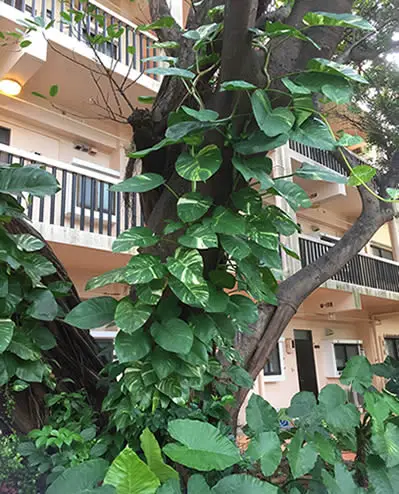
This plant is referred to by many different names that include; golden pothos; Ceylon creeper; hunter’s robe; ivy arum; money plant; silver vine; Solomon Islands ivy; marble queen; taro vine. It’s most common unofficial names are devil’s ivy and devil’s vine.
Is pathos a succulent?
Pothos has some similar care needs to succulents, especially as those care needs relate to watering, but it is not a succulent.
Pothos is an evergreen flowering vine.
Unlike succulents, pothos has aerial roots that it uses to climb surfaces. These roots thus require more airflow than succulents making succulent soil unsuitable for growing this vine.
Pothos are not a naturally a slow growing plant
Pothos are not a slow growing plant. In the wild pothos can grow at a rate of 18″ – 24″ per month. However, when grown as a houseplant this fast growth rate is considerably reduced.
You can expect a pothos houseplant, that is being given the correct care, to grow at half the rate of a wild pothos plant.
Many pothos houseplant owners get frustrated by the slow growth of their plant especially when they learn that this vine is actually normally a very fast grower. So, why would your pothos be growing slow?
Your pothos is growing slow because you are not giving it the proper care it needs. Pothos is a fast growing vine that, although slowed down when cultivated indoors, still grows fast compared to other houseplants.
So if you are wondering, why do pothos take so long to grow, it’s simply because the plant is not getting the care that it needs.
How quickly you should you expect your pothos to grow indoors
As I mentioned above pothos is a fast growing plant in its native habitat but when it is grown indoors this fast rate of expansion is reduced considerably.
You can expect a well-cared-for pothos houseplant, that is getting all its needs met properly, to grow at a rate of about 12″ per month. However, do not be upset if your plant grows much slower than this as pothos will only grow fast if its care needs are 100% correct.
It should not be too much of a shock to learn that the same reasons pothos will not grow are often the same reasons responsible for a slow growing pothos. That is why I have included both these problems and their similar solutions in the same article.
The 10 causes for no pothos growth or slow growth
Below are the 10 causes for lack of growth in pothos:
- Incorrect light type and/or not enough light.
- Wrong soil.
- Insufficient nutrients.
- Incorrect temperature range.
- Incorrect watering routine.
- The plant may be rootbound.
- Disease.
- Pests.
- The plant has entered a phase of dormancy.
- Old age.
I will briefly explain the above problems as they relate to a non-growing pothos plant before giving you detailed instructions on how to alter your care routine to ensure, not only continued plant growth but also, growth at an accelerated rate.
Neglecting these 5 basic care needs can slow down a pothos’ growth
In the vast majority of cases a non growing, or extremely slow growing pothos, is due to an incorrect care routine.
I cover the main ways to kickstart the growth of a pothos below as they are also the same steps you need to take to increase the growth rate of a pothos.

The 5 basic care needs that can affect the growth, or cause a lack of growth, in a pothos are:
- Incorrect light.
- Incorrect soil/insufficient nutrients in the soil.
- Poor watering routine.
- Incorrect temperatures.
- In correct watering.
Later in this article, on the section about getting your pothos to grow faster. I cover the steps you must take to get the above basic care needs of this plant right, as getting the essentials correct will go a long way in encouraging your plant to grow and grow faster.
5 additional causes for slow pothos growth
But, before I do that I should briefly discuss what you need to do if your pothos is not growing at all due to other factors that are not directly related to the plant’s care routine.
1. Slow growth due to the pothos being rootbound
A rootbound pothos can, and should be, repotted.
You can either move the plant to a bigger pot to encourage larger growth or you can trim away about 1 quarter to 1 third of the rootball and replace it, with fresh soil, back in its original container if you want the plant to maintain its current size.
2. No pothos growth due to disease
If you find that your plant is diseased then you will need to take proper action to treat the plant. The most common pothos diseases, as outlined by Penn State, can all be treated with a good organic fungicide, like this one.
If the plant has been overwatered and developed root rot then you will need to take the actions steps that I outlined in the article on dracaena root rot and aloe vera root rot as these instructions apply to a pothos plant with the same condition. Those articles also outline how to diagnose this condition.
3. Slow pothos growth due to pest infestation
Pests can usually be easily spotted on the foliage of the plant and a good quality organic pesticide, such as neem oil, will make quick work of them.
If the plant has been infected by root attacking bugs then you may need to administer the treatment for root rot as well, as outlined in the articles previously mentioned.
4. No pothos growth due to dormancy
Pothos enters a completely natural stage of dormancy in the winter. During dormancy the plant will not grow.
If your plant has stopped growing in the winter there is nothing at all to worry about as it’s a completely natural part of the plant’s grow cycle.
5. No pothos growth due to old age
Pothos houseplants will only live for about a decade.
After 10 years you can expect the growth rate of a pothos houseplant to slow or even stop completely.
With an old pothos you are better taking a few cuttings and propagating new plants from them.
How To Grow Pothos Faster In 6 Simple Steps
For some indoor plant lovers when it comes to growing houseplants, they will admit, they’re not the most patient person ever. When starting from scratch it can take some plants too long to sprout for the impatient.
Can you make pothos grow faster?
The simple answer is, yes!
Here’s how to make pothos grow fast:
- Provide plenty of bright, indirect light.
- Use a fast-draining and airy, acidic soil.
- Set temps between 70 and 90 degrees Fahrenheit.
- Raise humidity to between 50 – 70 percent.
- Water about once a week.
- Fertilize with balanced liquid fertilizer.
- Prune your plant.
The following guide to fast pothos care will elaborate on all the points above so you can see more growth out of your devil’s ivy.
Before I give you detailed instructions I will briefly outline what a pothos plant is and explain its normal growth speed so that you have a better understanding of why the points I outlined above, for making your pothos grow faster, are important.
Be aware that the care instructions below should also be applied to a non-growing pothos.
Instructions On How To Grow Pothos Fast
To grow pothos faster you must ensure the plant is getting the correct care.
Although pruning will help (I cover this later), it is the essential care requirements that are responsible for the growth rate of this vine.
So, you must get the basic correct if you want to accelerate the growth of this vine.
1. Pathos light requirements for fast growth
By far the biggest reason for a non-growing pothos and a very slow growing pothos is incorrect light.
All houseplants use photosynthesis as a mechanism for converting light into simple sugars for sustenance and growth.
Although some plants need more light than others, and some need direct light while others require indirect light, a lack of light is more often than not the cause for growth problems in houseplants.
The kind of light a pothos needs
The great thing about pothos, and one of the reasons it is such as easy-care plant, is that as an indoor plant it can survive in all sorts of lighting conditions.
Obviously pothos needs enough light to grow but even if the pothos only gets medium light, it will survive. It will even survive if it is subjected to a low-light environment for a prolonged period.
However, there’s a difference between surviving and thriving.
The growth of a pothos will be slowed considerably without enough light. But bear in mind that not all light is created equal.
The best lighting for a fast growing, healthy and robust pothos is bright, indirect light.
You can position your pothos in front of a northerly or easterly-facing window, neither of which receives direct sun.
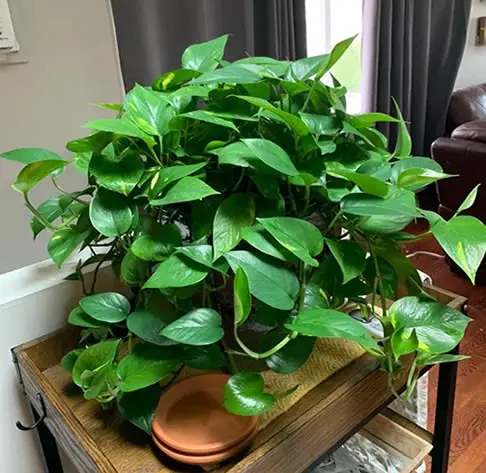
If the window gets strong direct light then it will be best to affix a curtain so the sunlight is somewhat muted.
Direct sunlight, contrary to common opinion, will not make pothos grow any faster. If anything, it will have the opposite effect.
In direct sunlight, the pothos’ gorgeous leaves will also likely burn.
Once the cells in a leaf die, there’s no fixing it. You’ll have to trim away the dead parts of the pothos leaf or remove the sunburned leaf completely. This is can be heartbreaking if you have to remove large sections of foliage on an otherwise appealingly variegated pothos!
It is therefore best to avoid placing pothos in the path of direct sunlight altogether.
The amount of light a pothos needs
You’ve got the lighting requirements down pat for the pothos, ensuring that your plant is only getting indirect light, but now you must determine how much light this lovely indoor plant needs per day.
Pothos requires at least 10 hours of good indirect light daily.
Now, we’re sure you’re wondering what you’re supposed to do on those cloudy, rainy, or snowy days when the sun never comes out. On that note, what about during the winter when daylight is in short supply?
Or, what if you only have a dimly lighted location available for your pothos?
A cheap artificial grow light can be used to augment the natural light your pothos receives so the plant always gets the minimum 10 hours of light it needs per day.
Houseplants cannot tell the difference between natural sunlight and artificial light. To your pothos, light is light, and no matter its source, your plant can photosynthesize and thrive.
What matters much more than the source of the light is its brightness, which is why dim light doesn’t encourage rapid pothos growth! So, if your plant is getting 10 hours of indirect light per day but that light is poor, i.e. the plant is located in a dim environment, then you should either relocate the plant or use a grow light.
2. The kind of soil a pothos needs for fast growth
The soil you select for a houseplant is critical for creating the right kinds of conditions for growth. Keeping that in mind, which type of soil best supports the pothos?
Pothos requires a well-draining soil that encourages good airflow.
As I mentioned previously pothos has some similar care requirements to succulents. Succulents need well-draining soil and so does pothos.
When you water your plant, the H2O can travel deep into the soil to reach the root system. It doesn’t get stuck or compacted, nor does standing water accumulate.
The roots can absorb the water. Since water is one of the major ingredients for photosynthesis to occur, a plant must get enough of it. We’ll talk a little later about how much to water a pothos and how often.
Although pothos is similar to a succulent in that it needs a soil that is fast-draining it requires something in the soil that succulents do not – good airflow.
Just as regular potting mixes are too dense and will retain too much water for pothos, succulent soil it choke the plant roots of oxygen. So the soil used for a pothos must encourage good airflow.
It’s not only how loose and aerated the soil is that matters for the pothos. The plant also requires some soil acidity too.
Pothos doesn’t need a lot of acidity. On the pH scale, a range of 6.1 to 6.8 more than suffices. That’s only a little on the acidic side and bordering on neutral.
So to recap a good pothos soil will:
- Be fast draining.
- Have improved airflow.
- Be nutritional balanced.
- Be slightly acidic.
There are preformulated pothos soils available, like this one, but what if you can’t get your hands on pothos soil, how do you mix your own?
Well, it’s easy enough to mix your own with easily-acquired ingredients.
Pothos soil mix:
- 2 parts peat moss or coir. At a pinch, you can use regular potting mix though it is better to create your mix soil-free.
- 1 part perlite or vermiculite. This will ensure good water drainage.
- 1 part oak bark, or pine bark or similar. This will help maintain good airflow in the soil.
3. The ideal pothos temperature range for fast growth
Originating in a tropical locale, it should come as no surprise that the pothos likes warm temperatures.
Luckily, the average household temperature range is perfect for pothos.
Keep the temperatures between 70 and 90 degrees Fahrenheit and your pothos will respond by growing well.
Placing the plant in a location that gets temperatures over 90°F creates conditions that are as unfavorable for pothos.
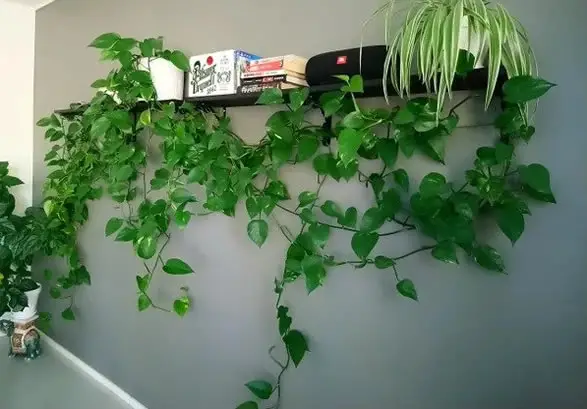
I sincerely doubt you’re going to let your home exceed 90°F so it is highly unlikely a pothos houseplant will experience temperature stress due to high temperatures. Your pothos will likely be more at risk from fluctuating temperatures.
Sharp spikes or dips in temperatures will negatively affect your pothos.
Triple-check that your pothos isn’t exposed to air drafts, be those from drafty doors or windows, a radiator, a window air conditioning unit, return vents, or even your fridge or freezer if the plant is close to the kitchen.
Although the ideal temperature range should be between 70°F and 90°F I find that you will have no problems if you ensure the localized temperature around your pothos plant is between 60°F – 85°F.
Avoid these low temperatures or pothos will not grow
Although it is unlikely your home will ever be too warm for your pothos it may sometimes be too cold. Many people find temperatures in the high 60s comfortable. Your pothos will not agree.
Really, 70 degrees fahrenheit is as low as you want to go for your pothos if you want the plant to continue growing.
Sustained temperatures under 60°F is too cold for a pothos plant.
Although pothos can survive short periods of cold, with temperatures as low as 50°F, prolonged periods of low temperatures will prevent the plant from growing.
4. How to use humidity to encourage faster pothos growth
You might have guessed that pothos will require a lot of humidity given its high temperature range and native habitat. You would have indeed guessed right.
Pothos likes humidity between 50 and 70 percent.
Is the plant more tolerable of low humidity conditions? Yes. But, as I mentioned earlier, there’s a difference between surviving and thriving. That difference is growth or lack thereof.
The average relative humidity in a building is between 30 and 50 percent. So more than likely your home is not humid enough for your pothos. Low humidity levels can result in your plant not growing or failing to grow as fast as it should.
If you have a bathroom with a window that gets indirect sunlight, your pothos will enjoy the humidity blasts every time someone takes a shower. Although bathrooms/shower rooms will provide higher humidity levels than other rooms in your home those higher humidity levels may be short lived. The same is true of misting the plant.
Misting can help increase humidity levels in the short term but the enhanced humidity does not last long enough to make any real difference to the plant.
A cheap plant humidifier is all you need and is, in fact, by far the best way to ensure your pothos has the humidity levels it needs without increasing the humidity levels in the room.
5. Watering a pothos correctly can help with faster growth
Watering a pothos is rather tricky as this plant has similar watering needs to that of a succulent. Mistakes in your watering routine can not only impede the plant’s growth but it could even kill it.
Before you water a pothos you must allow the soil to become mostly dry, and then you should water your pothos.
How long will this take? That’s hard to say. If you live in a warm region, your pothos might drink more of the water you feed it. If not, then the rest will be quickly drain away or evaporate.
That also happens during the spring and summertime if you live in a more temperate region.
For those who live in chillier regions, the lack of heat will prevent the water from prematurely evaporating. The pothos also won’t drink quite as greedily.
Water retention in the soil of pothos is an extremely serious problem that can lead to root rot and the death of the plant. So it is vitally important you get your watering schedule correct.
When to water pothos to encourage growth
The average timeline for watering a pothos houseplant is once every week or two. However, you should not stick to a set schedule until you know the watering needs of your individual plant.
Rather than follow a schedule, you should test the soil for moisture before watering the plant. There are two ways to do this.
The simplest way to check plant soil for moisture levels is to use the finger test. Push a clean index finger into the soil to a depth of about 1 1⁄2 inches.
If your finger comes out moist, or with soil debris stuck to it, wait longer to water. If your finger comes out clean or with dry dirt that is easily blown off then it’s time to water the plant.
A better way to know when your pothos requires watering is to use a cheap moisture meter. Push the spike of the meter down to a depth of about 1 1⁄2 inches and water the plant only when the monitor reads “dry”.
Remember that depriving pothos of water, though not as bad as overwatering it, is very stressful to the plant. The key to pothos growth is keeping its condition stable and never stressing it out. By using a moisture monitor you will ensure the plant is never dehydrated but also is never overwatered.
How to water pothos correctly
Although pothos can be watered from the top I find it best to water the plant from the bottom.
As long as it is done correctly, watering pothos from the bottom eliminates the risk of overwatering as it ensures the plant gets only the right amount of water that it needs.
Place your pothos in a sink of water for approximately 15 – 20 minutes. Ensure there is enough water in the sink to allow the plant to drink its fil but not so much water that it spills over the sides of the pot. A water level up to half way on the pot is usually enough.
When watering a pothos from the top, do so generously, but watch to see that the water is emptying out of the drainage holes and into the saucer.
If the excess water is not exiting the drainage holes as it should, then the soil could have become compacted and the plant could be rootbound (see earlier section above for dealing with this).
If the pot does not drain away excess water the pothos will be at risk of standing water. This can be rather dangerous, as saturated roots can rot and die, killing the rest of the plant if the fungal disease root rot develops.
6. Use fertilizer to stimulate faster pothos growth
Many people ask me, “should I use fertilizer pothos”.
The simple truth is, if you want to see your pothos grow then you must fertilize the plant.
You don’t need any special fertilizer per se. Most all-purpose houseplant fertilizers should suffice for pothos with a couple of caveats.
For one, pothos does best with liquid fertilizer, like this one. Don’t use powders or granules on pothos.
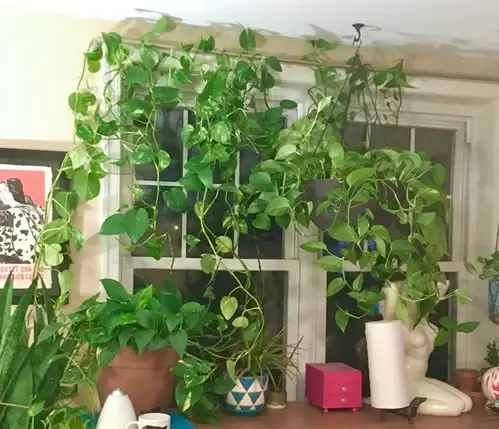
The mix of macronutrients should be fairly even. If you’re not familiar, plants utilize three macronutrients to grow. They are nitrogen, potassium, and phosphorus.
Some plants do best with more nitrogen than potassium or phosphorus, but the pothos needs all three in equal measure. Look for a fertilizer label that reads 10-10-10 or 20-20-20.
You will notice that your pothos will have a rather unconventional growing season compared to the rest of the plants in your indoor garden.
Rather than lay dormant all winter, the pothos comes out of dormancy and begins its growing season in December. That season stretches to May, a month when the rest of your plants will come alive.
Every two months during its active growing cycle, fertilize the pothos. This means you should apply fertilizer about twice during each active growing season. I know that doesn’t seem like a lot, but it’s all the pothos needs.
Over-fertilizing a pothos is worse than forgetting to fertilize it at all.
When you over-fertilize this plant, you inundate it with nutrients. Sure, your houseplant isn’t deficient, but all the salt that’s in fertilizer seeps into the soil and attacks the roots.
If you accidently overfertilize a pothos you will have to either flush the soil or replace the soil.
How To Grow Pothos Faster In Water
Below are some tips to ensure your pothos grows fast if you are cultivating the plant in a water-filled container such as a jar.
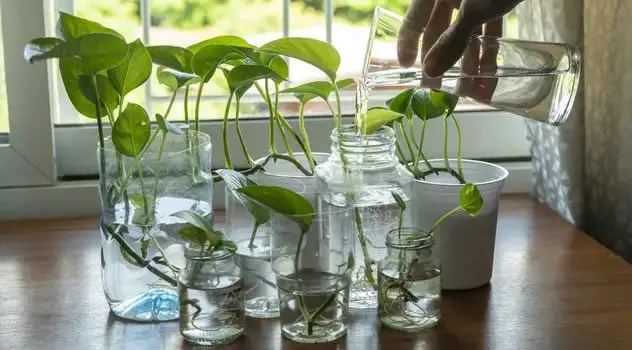
- Use a clear glass jar or clear container.
- Replace the water every week.
- Add a few drops of liquid feed to the fresh water – once per week only.
- Ensure the plant is getting at least 10 hours of strong indirect light.
- Ensure localized temperatures around the plant are between 70°F – 90°F.
- Keep the jar or container clean. A quick clean once per week when replacing the water will usually suffice.
How To Make Pothos Grow Fuller Faster
If you follow the above care instructions, then you might see as much as 18 inches of growth per month from your pothos. Over five months, that’s quite a lot of growth!
A problem you may then encounter with your particular pothos is that it becomes a little spindly. If you would like its long vines to grow closer together then you will want to know how to make the pothos fuller.
Here’s how it’s done.
- Prune your plant regularly.
- Water only when needed.
- Keep conditions warm and humid.
- Provide bright, indirect sunlight for about 10 hours per day.
- Don’t grow pothos too close to other plants.
Pothos pruning guide for fast growth
We have already covered all the points on how to grow a fuller pothos in the sections above except for pruning. So below I have given you a quick guide to effectively pruning your pothos for faster and fuller plant growth.
Many people wonder if it is actually a good idea to prune a pothos.
The truth is simple, if you want to encourage fuller growth then pruning your pothos is the only way to guarantee it.
When you should prune your pothos
Pruning any plant should not be a free-for-all. You want to make careful, conscious decisions when you take to the pruning shears, as whatever comes off can never reattach to the plant again. It’s better to cut too little than too much.
If your pothos has any dead or dying bits on its foliage, such as leaves or stems, those are obvious areas to remove first.
Any legginess can be trimmed away and this will be most apparent in a plant that is growing in dim conditions.
As for healthy, green pothos stems, any vines you see that have yet to grow leaves are fine to remove. If the plant hasn’t regrown leaves by the stage where stems are pronounced, it probably isn’t going to.
How to prune a pothos for faster growth
To wrap up, let’s discuss how to prune pothos to create lusher, fuller foliage.
Trim above the leaf node
Once you’ve chosen what to remove, take the pothos vine and look for the leaf node.

A leaf node is a swollen bump on a stem or vine where a new leaf will emerge.
From the leaf node, measure out about ¼ inch. Then make a 45-degree cut there.
Keeping the leaf node on the vine allows that vine to grow new foliage.
Take periodic breaks to assess your progress
As you continue trimming other vines on the pothos, remember not to get too gung-ho.
After every couple of snips take a few seconds, step back a few feet and check out your plant. To reiterate, you can’t reattach what you cut, so don’t trim too much!
Always follow the golden pruning ratio
There’s what’s known as the golden pruning ratio among houseplant enthusiasts and indoor gardeners.
No matter what kind of pruning you think your plant needs, you shouldn’t cut more than 1/4th of its foliage overall.
That’s why taking breaks is so important. You can’t really assess how much of the pothos or any other plant you’ve cut when you’re in the thick of it trimming vines.
Disinfect your pruning shears regularly
The last step is much more important than most people think it is.
Ideally, between every snip, and certainly when you’re finished pruning, you want to disinfect your pruning shears or whatever cutting tool you used.
The reason? Cleaning your tools prevents the spread of disease from shears to plant and from plant to plant.
Yes, all it takes is cutting a healthy plant with infected shears to spread some bacterial and fungal conditions.
To ensure the shears are clean some plant owners will soak them for 30 minutes in a bleach bath. Filling a small basin with 70-percent isopropyl alcohol will also disinfect the shears.
However, I find this approach to be completely unnecessary if you use simple alcohol wipes to wipe down the blades before and after use.
How to train a pothos to grow down fast
Now that you know how to rekindle a non-growing pothos’ growing cycle and how to encourage the plant to grow faster let’s look at how to train the plant to grow the way you want it to.
Pothos is a natural climber. Its aerial roots attach to surfaces and allow the plant to grow upward making it an excellent flowering plant for trellis. But, what if you’d prefer your pothos to grow down so you can use it as a hanging plant (like the Hindu rope plant for example)?
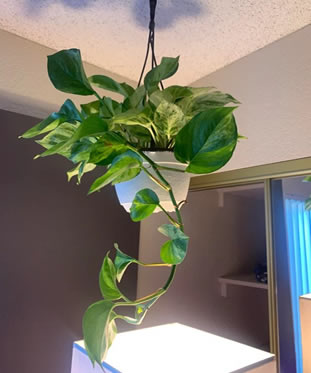
To make pothos grow down so it is a hanging vine, instead of the climbing vine is naturally wants to be, simply remove any support for the growing foliage.
By ensuring there is no nearby wall support, for the vine to climb up, you leave the plant no option but to grow downwards.
Pruning the foliage will encourage faster growth and also allow you to shape the trailing vines.

